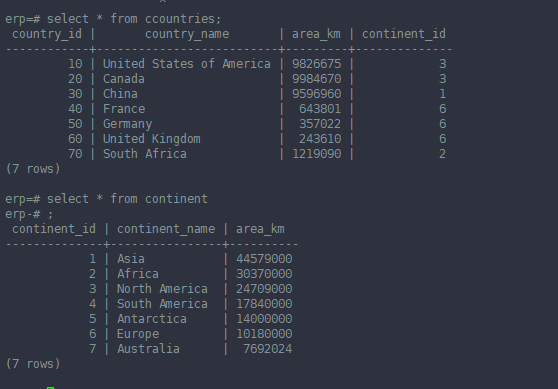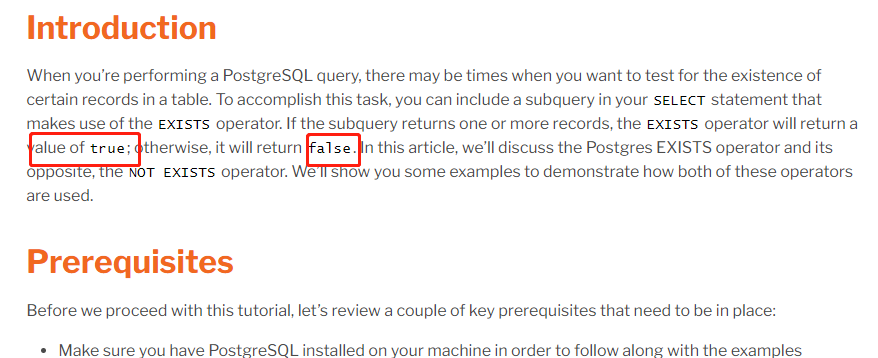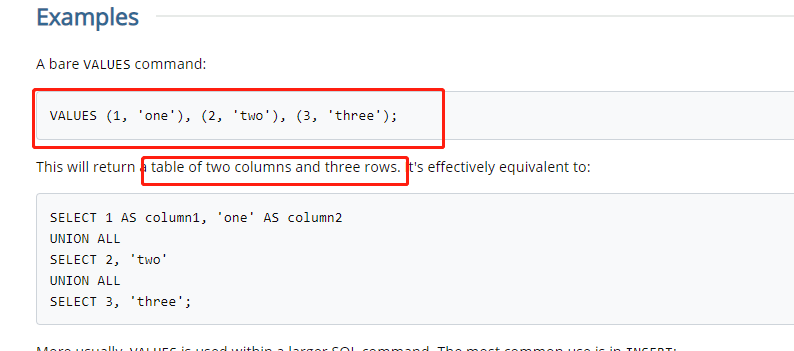原文: https://www.postgresql.org/docs/9.0/sql-values.html

另外: exists 子句的用法
SELECT * FROM continent WHERE EXISTS (SELECT * FROM ccountries where continent.continent_id = ccountries.continent_id);
https://kb.objectrocket.com/postgresql/how-to-use-the-postgres-exists-operator-1267


———————
Conclusion
When you need to test for the existence of certain records in a PostgreSQL table, the Postgres EXISTS operator is the tool you need to get the job done. In this article, we examined both the EXISTS and NOT EXISTS operators and checked out some examples of their use. With our explanations and examples, you’ll be prepared to utilize these operators in your own PostgreSQL queries.
———————————————————————
问题: 下面这个语句不好理解:

————————————————————————————————————————————————————————

VALUES
Synopsis
VALUES ( expression [, ...] ) [, ...]
[ ORDER BY sort_expression [ ASC | DESC | USING operator ] [, ...] ]
[ LIMIT { count | ALL } ]
[ OFFSET start [ ROW | ROWS ] ]
[ FETCH { FIRST | NEXT } [ count ] { ROW | ROWS } ONLY ]
Description
VALUES computes a row value or set of row values specified by value expressions. It is most commonly used to generate a "constant table" within a larger command, but it can be used on its own.
When more than one row is specified, all the rows must have the same number of elements. The data types of the resulting table's columns are determined by combining the explicit or inferred types of the expressions appearing in that column, using the same rules as for UNION (see Section 10.5).
Within larger commands, VALUES is syntactically allowed anywhere that SELECT is. Because it is treated like a SELECT by the grammar, it is possible to use the ORDER BY, LIMIT (or equivalently FETCH FIRST), and OFFSET clauses with a VALUES command.
Parameters
- expression
-
A constant or expression to compute and insert at the indicated place in the resulting table (set of rows). In a VALUES list appearing at the top level of an INSERT, an expression can be replaced by DEFAULT to indicate that the destination column's default value should be inserted. DEFAULT cannot be used when VALUES appears in other contexts.
- sort_expression
-
An expression or integer constant indicating how to sort the result rows. This expression can refer to the columns of the VALUES result as column1, column2, etc. For more details see ORDER BY Clause.
- operator
-
A sorting operator. For details see ORDER BY Clause.
- count
-
The maximum number of rows to return. For details see LIMIT Clause.
- start
-
The number of rows to skip before starting to return rows. For details see LIMIT Clause.
Notes
VALUES lists with very large numbers of rows should be avoided, as you might encounter out-of-memory failures or poor performance. VALUES appearing within INSERT is a special case (because the desired column types are known from the INSERT's target table, and need not be inferred by scanning the VALUES list), so it can handle larger lists than are practical in other contexts.
Examples
A bare VALUES command:
VALUES (1, 'one'), (2, 'two'), (3, 'three');
This will return a table of two columns and three rows. It's effectively equivalent to:
SELECT 1 AS column1, 'one' AS column2 UNION ALL SELECT 2, 'two' UNION ALL SELECT 3, 'three';
More usually, VALUES is used within a larger SQL command. The most common use is in INSERT:
INSERT INTO films (code, title, did, date_prod, kind)
VALUES ('T_601', 'Yojimbo', 106, '1961-06-16', 'Drama');
In the context of INSERT, entries of a VALUES list can be DEFAULT to indicate that the column default should be used here instead of specifying a value:
INSERT INTO films VALUES
('UA502', 'Bananas', 105, DEFAULT, 'Comedy', '82 minutes'),
('T_601', 'Yojimbo', 106, DEFAULT, 'Drama', DEFAULT);
VALUES can also be used where a sub-SELECT might be written, for example in a FROM clause:
SELECT f.*
FROM films f, (VALUES('MGM', 'Horror'), ('UA', 'Sci-Fi')) AS t (studio, kind)
WHERE f.studio = t.studio AND f.kind = t.kind;
UPDATE employees SET salary = salary * v.increase
FROM (VALUES(1, 200000, 1.2), (2, 400000, 1.4)) AS v (depno, target, increase)
WHERE employees.depno = v.depno AND employees.sales >= v.target;
Note that an AS clause is required when VALUES is used in a FROM clause, just as is true for SELECT. It is not required that the AS clause specify names for all the columns, but it's good practice to do so. (The default column names for VALUES are column1, column2, etc in PostgreSQL, but these names might be different in other database systems.)
When VALUES is used in INSERT, the values are all automatically coerced to the data type of the corresponding destination column. When it's used in other contexts, it might be necessary to specify the correct data type. If the entries are all quoted literal constants, coercing the first is sufficient to determine the assumed type for all:
SELECT * FROM machines
WHERE ip_address IN (VALUES('192.168.0.1'::inet), ('192.168.0.10'), ('192.168.1.43'));
Tip: For simple IN tests, it's better to rely on the list-of-scalars form of IN than to write a VALUES query as shown above. The list of scalars method requires less writing and is often more efficient.
Compatibility
VALUES conforms to the SQL standard. LIMIT and OFFSET are PostgreSQL extensions; see also under SELECT.